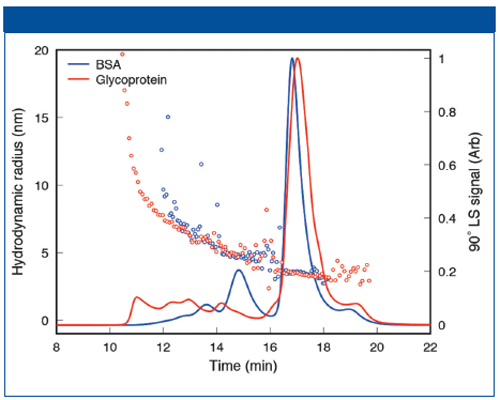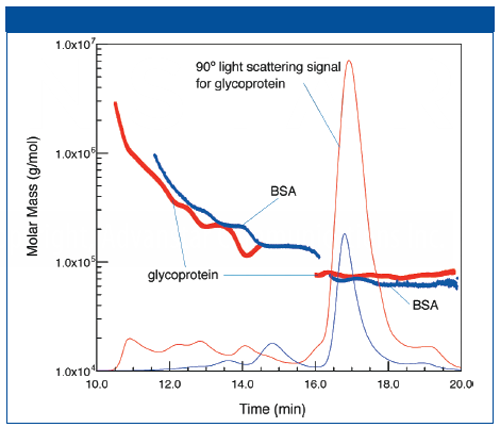On-Line MALS-QELS (Quasi‑Elastic Light Scattering)
While on-line multi-angle light scattering (MALS) is one of the most important techniques for macromolecular characterization, it can be made even more versatile with the addition of a quasielastic light scattering (QELS, a.k.a. dynamic light scattering) module for determination of hydrodynamic radius. QELS can be added to a Wyatt MALS system as a WyattQELS™ module embedded in the MALS instrument, or by connecting the MALS flow cell to a batch DLS instrument such as a DynaPro® NanoStar® or Mobius® via optical fibre. The QELS instruments can be used to determine the hydrodynamic radius, rh , for a variety of samples in a continuous‑flow mode. The combined MALS-QELS system will measure simultaneously rg, rh, and the absolute molar mass.
Wyatt Technology
While on-line multi-angle light scattering (MALS) is one of the most important techniques for macromolecular characterization, it can be made even more versatile with the addition of a quasielastic light scattering (QELS, a.k.a. dynamic light scattering) module for determination of hydrodynamic radius. QELS can be added to a Wyatt MALS system as a WyattQELS™ module embedded in the MALS instrument, or by connecting the MALS flow cell to a batch DLS instrument such as a DynaPro® NanoStar® or Mobius® via optical fibre. The QELS instruments can be used to determine the hydrodynamic radius, rh , for a variety of samples in a continuousâflow mode. The combined MALS-QELS system will measure simultaneously rg, rh, and the absolute molar mass.
Since rg (the root mean square radius) is determined directly from the angular dependence of the scattered light intensity, at least three angles are required to make a reliable measurement. On the other hand, rh is derived from the fluctuations of light scattering intensity because of diffusion of the molecules (aka Brownian motion) and a single measurement angle suffices.
The QELS measurement is performed on-line in the DAWN flow cell. State-of-the-art optical design, high sensitivity, minimal dead volume, and ease-of-use are the hallmarks of the DAWN detectors. These characteristics, among others, enable them to produce superior signalâto-noise, stability, and sensitivity.
An optical fibre receiver is mounted in the read head of the MALS detector at any angular location. The fibre is, in turn, coupled to an avalanche photodiode in an autocorrelator that has been specially modified to accept the signal from the DAWN instrument.
Figure 1: The hydrodynamic radius versus time for BSA and a glycoprotein, obtained from SEC coupled to on-line MALS-QELS detection. The measurements of size (shown here) and molar mass (shown below) can be combined to learn about molecular conformation.

This application note illustrates the results obtained for bovine serum albumin, BSA, and a glycoprotein, which were separated using a size-exclusion chromatograph (SEC). The MALS-QELS detector determined the hydrodynamic radius versus elution time for the two proteins completely independent of the elution time. Figure 1 shows these results with the 90° LS signal superimposed. For these particular samples, rg was below the MALS rh measurement limit of 10 nm. However, simultaneous measurements of MALS and QELS in the integrated system provide complete results for rh and molar mass (even though the small radius cannot be measured by MALS, molar mass measurements are not impacted). Figure 2 shows the molar mass results determined by the DAWN and the RI detector.
Figure 2: Absolute molar mass versus time for BSA and glycoprotein samples superimposed with the signals from 90 LS detector obtained from size-exclusion chromatography with MALS detection. Glycoprotein aggregates with similar molar mass as BSA aggregates elute earlier due to their extended hydrodynamic size. MALS provides accurate molar mass, regardless of elution time.

The MALS-QELS combination allows the simultaneous determination of absolute molar mass, root-mean-square radius (rg from about 10–500 nm), and hydrodynamic radius (rh from about 0.5–300 nm). Conformation results can now be obtained for molecules ranging from 200 g/mol to hundreds of millions of g/mol.

Wyatt Technology
6330 Hollister Avenue, Santa Barbara, California 93117, USA
Tel. +1 (805) 681 9009
Website:www.wyatt.comE-mail:info@wyatt.com


.png&w=3840&q=75)

.png&w=3840&q=75)



.png&w=3840&q=75)



.png&w=3840&q=75)














